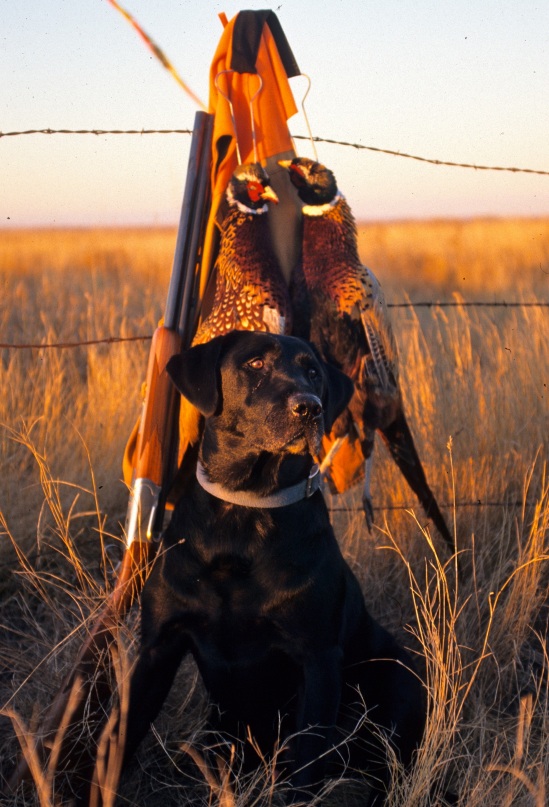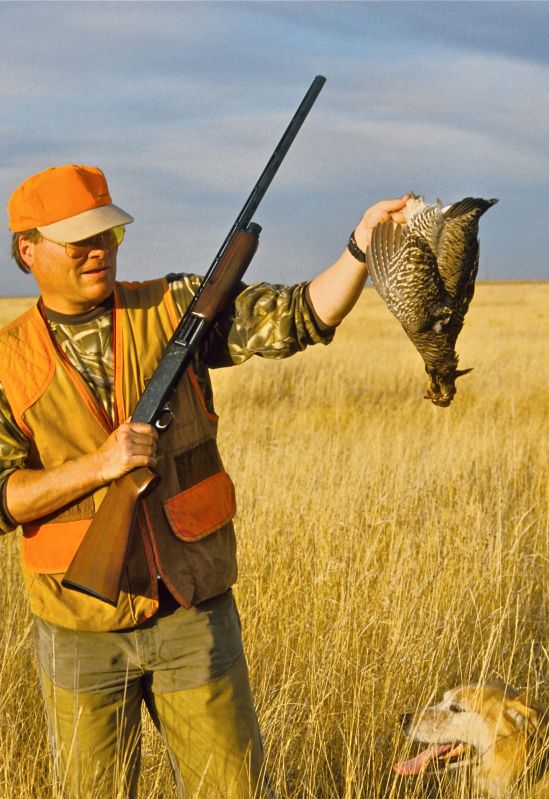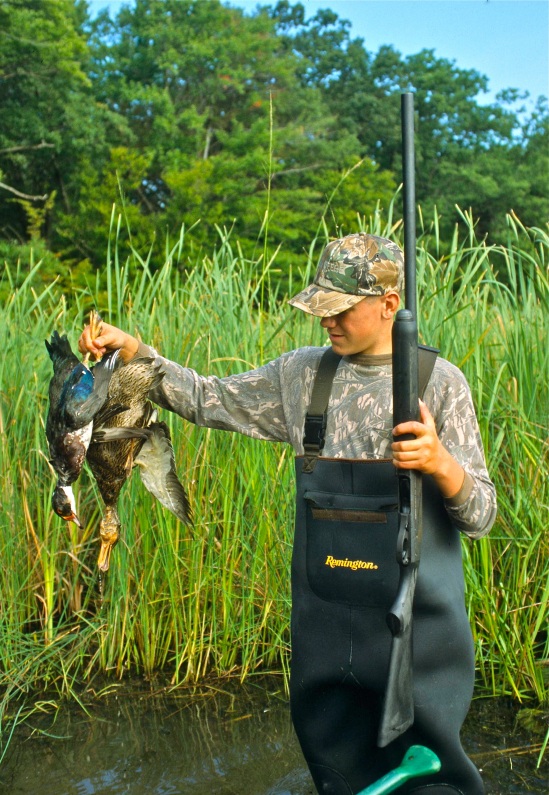Two factors are of critical importance to maintaining healthy pheasant populations: weather and available habitat. While these elements affect pheasants year-round, they’re highlighted annually as the harshest season comes to an end and pheasants begin their next reproductive cycle. A tough winter can certainly result in adult bird mortality, but the real key is getting healthy and strong hens into spring nesting season. Healthy hens lead to larger clutches of eggs, which adds up to more chicks headed toward autumn.

Kansas Pheasants
Generally speaking, the winter of 2013-2014 was toughest on pheasants and pheasant habitat in the Great Lakes region where heavy snows and bitter cold made for a long winter that continues despite the calendar turning to spring. Meanwhile, the Dakotas experienced a relatively mild winter, while the lack of snow accumulation across parts of the Great Plains has biologists concerned, the moisture being needed to restore habitat conditions following three years of drought. Here’s a state-by-state breakdown:
Editor’s Note: Additional states may be added as information becomes available.

Colorado
While other regions of pheasant country experienced too much snowfall, it’s been the exact opposite in Colorado, where the state’s pheasant population has been tremendously suppressed by two years of extreme drought. “This winter has been drier than preferred in terms of the potential to rebuild soil moisture levels necessary to encourage development of this year’s nesting cover, brood cover and survival habitats,” says Ed Gorman, small game manager with the Colorado Division of Wildlife, “Residual nesting cover is very limited after successive drought years, which will likely force hens to nest in annually available habitats.” While pheasant survival has not been reduced by the few winter weather events that have occurred, Gorman says much more moisture is needed to improve the degraded habitat conditions, and a few more winter events, even if severe, would have been welcomed. “Recovery begins with significant precipitation (either rain or snow) that will allow habitat to recover.”
Illinois
Northern Illinois counties (north of I-80) were hit with a lot of snow, some ice and very cold temperatures that kept the snow and ice on the ground for several months, according to Stan McTaggart, agriculture and grassland program manager with the Illinois Department of Natural Resources. At first glance, those conditions indicate bad news for upland birds, but McTaggart isn’t rushing to judgment. “Preliminary observations from current research on two Pheasant Habitat Areas are showing surprisingly limited losses so far this winter. The generally good survival of birds in these areas may not be typical of all birds in Illinois as these study areas provide some of the best habitat in the state. Birds in marginal habitat may not have fared as well.” In what hopefully signals a trend going forward, McTaggart notes an uptick in enrollment in Illinois’ State Acres For Wildlife Enhancement (SAFE) program, which helps conserve upland habitat.
Indiana
It’s been a tough winter for birds in Indiana, where the state recorded its sixth coldest winter and a top-three measurement of snowfall across the pheasant range of Indiana, according to N. Budd Veverka, Farmland Game Research Biologist with the Indiana Division of Fish and Wildlife.
Iowa
Snowfall has been significant in northeast, north-central, and the east-central regions of Iowa, continuing an unprecedented run of snowy winters topping more than 30” of accumulation. History says that doesn’t bode well for the pheasant population, but that’s presuming a wetter-than-normal spring ensues, which is typical after a snowy winter. Areas that didn’t receive as much snow this year included the southwest and west-central regions of Iowa, according to Todd Bogenschutz, upland wildlife research biologist with the Iowa Department of Natural Resources. Bogenschutz is optimistic that pheasant and quail numbers can improve in the southern half of the state this year, and the best bit of news is once continuous Conservation Reserve Program (CRP) signups begin, 50,000 acres will be available through the Iowa Pheasant Recovery program.
Kansas
Moisture is also the name of the game in Kansas, where precipitation this winter has been normal to below-normal depending on location. “Following three years of extreme drought across most of the state, spring precipitation will be necessary to replenish soil moisture and create adequate conditions for pheasant production,” says Jeff Prendergast, small game specialist with the Kansas Department of Wildlife, Parks and Tourism. While late summer 2013 rains improved habitat conditions slightly, winter wheat is important for providing nesting cover in Kansas, and as of last fall, 22 percent of winter wheat was rated poor to very poor, with just 34 percent rated good to excellent. On the habitat front, Prendergast says his department is working to concentrate additional resources into the two recently-established “Pheasant Focus Areas” in the state.
Michigan
Like the other Great Lakes states, Michigan’s pheasants have suffered through a long winter. Pheasants Forever was excited to announce the addition of Bill Vander Zouwen earlier this month as our new regional representative for the state. Vander Zouwen brings 20 years of top level experience as the former wildlife section chief for the Wisconsin DNR. In his role with Pheasants Forever, Vander Zouwen will be focused on the Michigan Pheasant Restoration Initiative, which has a goal to reestablish pheasant habitat on key areas across the state.
Minnesota
Serious winter weather arrived early in Minnesota and hasn’t left yet. “This has been an extremely cold winter. Many areas have experienced more than 50 days with minimum air temperatures at or below 0°F,” says Nicole Davros, upland game project leader with the Minnesota Department of Natural Resources, “Snow drifts have filled all but the largest cattail marshes, so good winter cover has become more limited. Birds are taking advantage of food plots and are utilizing roadsides in areas where the snow has become too deep or crusted over.” Davros notes deep snow didn’t develop until late January, and the deepest snow depths occurred outside the state’s core pheasant range. And within that core range – west-central, southwest, and south-central areas of the state – strong winds helped keep fields open for feeding. While the winter has been tough at times, it pales in comparison to the 58,000 acres of undisturbed grassland habitat lost in the state’s pheasant range. To combat this acreage loss, Minnesota continues to permanently protect habitat through land acquisition via its voter-approved Legacy Amendment. Hunters will be happy to hear the state is also expanding its Walk-in Access (WIA) program from 28 to 35 counties in 2014.
Missouri
Like points further north, Missouri’s winter was characterized by record lows and numerous large snowfall events, says Beth Emmerich, resource scientist with the Missouri Department of Conservation, who adds that because cover and food resources were impacted by the severe weather, she expects birds will be going into breeding condition in relatively poor condition.
Montana
While winter arrived early and a stretch of December included prolonged snow and cold, a warm-up in mid-January melted most of the snow in most of eastern Montana, and there’s been little snowfall since. “The lack of snow cover throughout most of the winter, current habitat conditions and an abundance of food mean pheasants have fared well throughout most of their range,” says Ryan Williamson, Region 6 upland game bird biologist for the Montana Department of Fish, Wildlife & Parks. While no firm prediction about the breeding season can be made yet, Williamson says if the mild winter continues and spring conditions play out favorably, it should be a good breeding season. “We often get late winter and early spring snow events that can delay nesting (as witnessed in the spring of 2011 and a little in 2013) but as of now, the winter shouldn’t have had a huge impact on the birds’ bodies or habitat conditions,” he says. Last year’s favorable weather generated some of the best habitat conditions in Montana in a long time, but while the quality improved, it’s the overall quantity that has upland game managers and hunters concerned. “. The largest impact right now on the landscape is the huge decrease in CRP acres across the state, particularly across northern Montana (Hi-Line),” Williamson says, “The CRP loss since 2010 is just over 1 million acres for the state, with more than 500,000 acres in the last year (2012-2013). Of those 500,000, almost 330,000 acres were across the Hi-Line.” Like other continuous Conservation Reserve Program (CRP) practices across the country, landowners in Montana were very receptive to the state’s Pheasant and Prairie Pothole State Acres For Wildlife Enhancement (SAFE) programs, enrolling and using up the available allotment quickly and protecting habitat in the process.
Nebraska
The winter in Nebraska has been defined by cold. “There have been periodic snow events across the state, but nothing I would classify as devastating. I don’t expect a huge impact on pheasants, but it was very cold for long periods of time,” reports Dr. Jeffrey J. Lusk, Upland Game Program Manager with the Nebraska Game & Parks Commission. Nebraska’s pheasant population is still reeling from a double whammy of habitat loss and drought, but Lusk reports the southwest portion of the state – where pheasant abundance has typically been highest – is poised to bounce back provided there’s adequate moisture this spring to promote lush nesting habitat. It’s also in southwest Nebraska where Lusk says the state is looking more closely at a promising wheat-stubble incentive program. “During the drought, most successful hunters in the area reported hunting wheat stubble fields,” Lusk said, adding the study will be extended a few more years.
North Dakota
Winter started out early and extreme in December, but since then, pheasants have been spared from brutal conditions. “A lack of snow has provided many feeding areas, birds are able to feed on uplands, and little stress has been noted in birds because they can get to food,” reports Stan Kohn, upland game management supervisor with the North Dakota Game & Fish Department. Snow cover may even be too low in some areas. “The lack of snow cover to date may set the stage for dry conditions throughout many counties in southwest North Dakota that were showing borderline drought conditions late last summer,” Kohn said, noting that snowfall in the state’s pheasant range is about 50 percent below normal. And at the northern edge of pheasant country, North Dakota hasn’t fully escaped winter’s wrath until May. “A big unknown will be weather conditions in this part of the country in the next six weeks,” Kohn says, “Late spring snowstorms can be a real problem with pheasants in March and early April.” While grassland conversion is continuing at a rapid pace in North Dakota, Kohn notes his department is promoting new habitat options for expired/expiring Conservation Reserve Program (CRP) lands, as the North Dakota Game & Fish Department has received a $1.9 million grant through the state’s Outdoor Heritage Fund to direct toward this effort.
Ohio
Ohio pheasants took a hit this winter, which was a severe period featuring snowfall, long durations of snow cover and extreme cold. “Ohio pheasants undoubtedly struggled to find sufficient food and cover during this severe winter,” reports Mark Wiley, wildlife biologist with the Ohio Department of Natural Resources Division of Wildlife, “A typical Ohio winter has intermittent snow cover, which provides pheasants with ample opportunity to forage for waste grain and other seeds on the bare ground. This year, persistent snow cover likely forced pheasants to venture further from shelter in search of food, thereby increasing the risk of predation.” Wiley notes there is a habitat bright spot: More than 10,000 acres in the Ohio Pheasant State Acres For Wildlife Enhancement (SAFE) program will be available as a continuous signup practice as part of the Conservation Reserve Program (CRP), acres that will only be available within the primary pheasant range in the state.
South Dakota
South Dakota’s pheasant range has received only about 50 percent of its normal snowfall this winter, which is good news for the nation’s largest pheasant population. “Pheasant winter survival is higher when there is minimal snow cover such as this past winter,” says Travis Runia, lead pheasant biologist with the South Dakota Game, Fish and Parks Department, “The winter has not been stressful to pheasants this year and we expect that survival was higher than normal. Our population usually increases after winters with below normal snowfall, given nesting conditions are also favorable.” Runia notes a very severe blizzard did occur in the western quarter of South Dakota, which likely resulted in high mortality of pheasants outside their primary range, but in the rest of the state’s cattail sloughs and shelterbelts are providing excellent winter habitat due to the limited snow cover. With hopes turning to a productive breeding season, the state’s Pheasant Habitat Work Group, appointed by Governor Dennis Daugaard, continues its work. “The group is tasked with reviewing the many habitat-related comments received in conjunction with the Governor’s Pheasant Habitat Summit, which was held in December,” Runia says, “The group will deliver a report to the governor with a list of practical solutions to the many threats to pheasant habitat in the state by the summer of 2014.” With fingers crossed for a productive spring nesting season, South Dakota appears set for an autumn pheasant rebound.
Wisconsin
Like their Viking neighbors to the west, “The Dairy State” has suffered through a long and cold winter. Pheasants Forever was excited by the embrace of the 21,000 people who attended National Pheasant Fest & Quail Classic in Milwaukee this past February, demonstrating the state’s enthusiasm for the uplands. In particular, Pheasants Forever was encouraged by the 136 landowners representing 30,000 acres who visited the Landowner Habitat Help Desk for conservation assistance during the event.
Field Notes are compiled by Anthony Hauck, Pheasants Forever’s Online Editor. Email Anthony at AHauck@pheasantsforever.org and follow him on Twitter @AnthonyHauckPF.
0.000000
0.000000
 Image by gnatoutdoors.com
Image by gnatoutdoors.com
 Image by gnatoutdoors.com
Image by gnatoutdoors.com
 Image by gnatoutdoors.com
Image by gnatoutdoors.com
















